As a result of the increasing focus the world has on indoor air quality (IAQ), there has been a demand for better ventilation and filtration — how effective products are at ridding of harmful contaminants while bringing in clean, fresh air — and better decarbonization and electrification efforts that are necessitated by evolving energy and building code requirements. All this means that manufacturers have to adapt products to meet these standards or get rid of products that don’t.
On the trade show floor at the AHR Expo in Chicago, manufacturers discussed these trends and showcased some product offerings that meet the current needs (and standards and regulations) of IAQ in the HVAC industry and real-world applications.
Code Requirements
Regardless of what is going on in the IAQ marketplace, there is always a need for IAQ solutions — healthier air is always better, and always the goal. At the same time, energy codes and standards are affecting the way those IAQ solutions can be delivered.
As of 2024, direct-expansion dedicated outdoor air systems (DX-DOAS) with a capacity less than 324 lb/hr of moisture removal capacity will have to be rated for efficiency and meet the minimums outlined in ASHRAE 90.1-2019 as required by DOE rulemaking.
“The cost to certify the performance of a DOAS unit is significantly different than the costs to do air conditioning,” said Paul Stewart, vice president of sales for Desert Aire.
As the compliance date approaches, Stewart says the cost of testing or certification may ultimately lead to some manufacturers considering the breadth of offerings.
“Desert Aire was one of the first manufacturers of DX-DOAS for split systems and WSHP and have expanded the line to many of the different categories including air-cooled, water-cooled, and water-source heat pumps, all with and without energy recovery,” Stewart said. “Because we have very efficient systems and very good refrigeration technology, meeting the minimum efficiency is not an issue, but we will need to constantly weigh the costs to complete the testing of each of the many different configurations we offer.”
Desert Aire currently has an enthalpy wheel energy recovery option for their DX-DOAS systems. One of the products Desert Aire showcased on the AHR show flow this year was a plate heat exchanger energy recovery ventilators (ERV) that can be used as a pretreatment to a DOAS system.
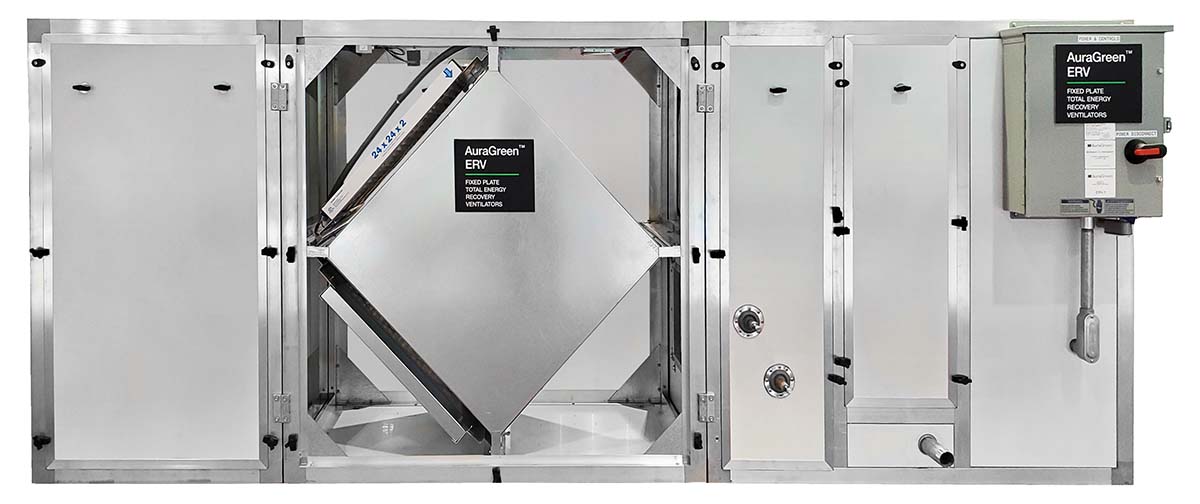
ENERGY RECOVERY: The AuraGreen ERV can be used as a pretreatment to DOAS systems – pictured without the side panel on the center section so that the crossplate heat exchanger is exposed and easily visible. (Courtesy of Desert Aire)
“I think we're going to see more plate heat exchanger energy recovery,” Stewart said. “The plate heat exchangers are less maintenance, fewer things to go wrong, and that technology is going to become a lot more common over the next few years, especially with the push for energy conservation.”
Electrification and Decarbonization
It’s no secret that decarbonization and electrification have been amplified in the industry — the move towards heat pumps, and being more energy efficient and sustainable, has led to the aforementioned code requirements.
“It leads to awareness of the quality of air that occupies a space,” said Gus Olivera, director of engineering at Addison.
As a result, manufacturers have to change their approach and ensure their products are energy-conscious where they can and have to be.
Addison recently introduced the MX Series modular air handler, or HybridAir — an all-in-one air handling solution that merges air, water, and refrigeration.
HybridAir utilizes a wrap-around DX system to ensure that incoming air undergoes preprocessing before ever reaching the hydronic coil, with subsequent reheat from the post-hydronic condenser coil, performing in even neutral conditions. The technology tackles the challenges of managing reheat without having to rely on traditional energy sources, Olivera said, resulting in less energy use.
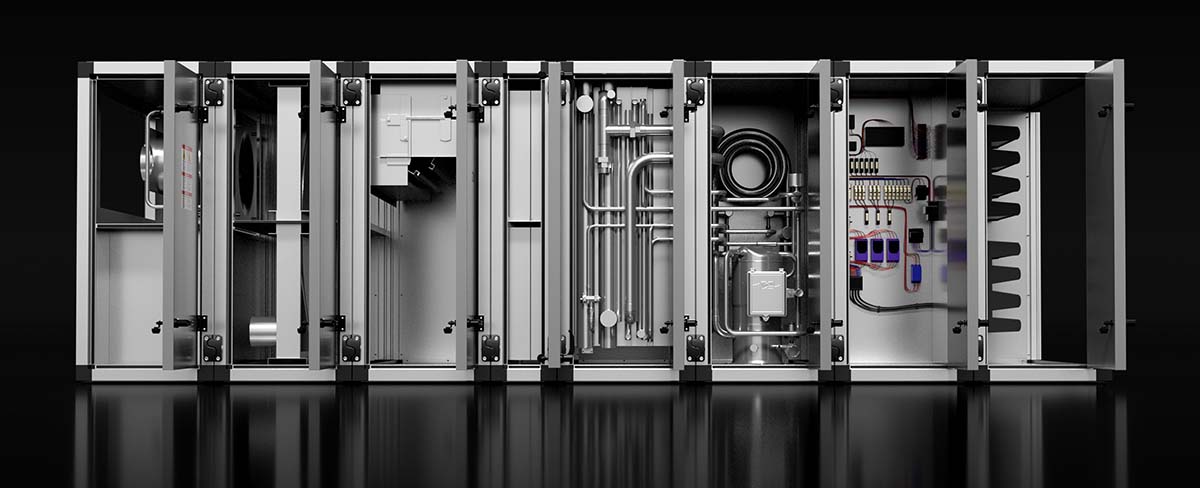
HYBRID AIR: HybridAir utilizes a wrap-around DX system to ensure that incoming air undergoes preprocessing before ever reaching the hydronic coil, with subsequent reheat from the post-hydronic condenser coil. (Courtesy of Addison)
In addition, HybridAir can accommodate diverse needs when specific areas demand different conditions from its prevailing building mode. The system can also be paired with other heat pump technologies, and the water-source versions of the product can even recapture some of the energy spent in hydronic cooling and utilize it for reheat. The recovered energy is captured per ASHRAE 90.1 for reheat, with no need for hydronic loops or additional systems.
“The chillers that are installed in the building have to work less, so you save energy,” Olivera said.
The product is also designed sort of like Legos, Olivera said. Each section is divided into separate parts and it ships that way, but it ships with charge already in it, making it easy to configure.
The electrification of the industry has brought on more of a demand for heat pumps, said Tom Maskel, AprilAire vice president of product management. With that comes implications for whole-home humidification.
What AprilAire has done is designed a unit to increase the capacity of the humidification unit. In addition, the company designed a completely new valve system that not only improves the performance and the output of the unit but actually reduces wastewater by 60%.
"In conventional humidifiers, water that remains unevaporated or unabsorbed is typically expelled through the drain," explained Maskel. "In contrast, our innovative advancement captures the water, recirculates it with fresh water, and, at the conclusion of the humidification cycle, a valve opens to facilitate drainage."
The great news about decarbonization and electrification, along with air quality solutions, according to TJ Wheeler, senior vice president of sales and marketing at Friedrich, is that these trends can work and integrate together. Friedrich combines technologies like low ambient heat pump operation, with integrated IAQ solutions into several of their product offerings, including their FreshAire Packaged Terminal Air Conditioners (PTACs) and the Vert-I-Pak.
“Ver-I-Pak is the first and only complete line of M1-compliant single package vertical heat pumps (available in 9K, 12K, 18K, and 24K Btu), supporting decarbonization efforts with heat pump operation down to 10°F,” Wheeler said.
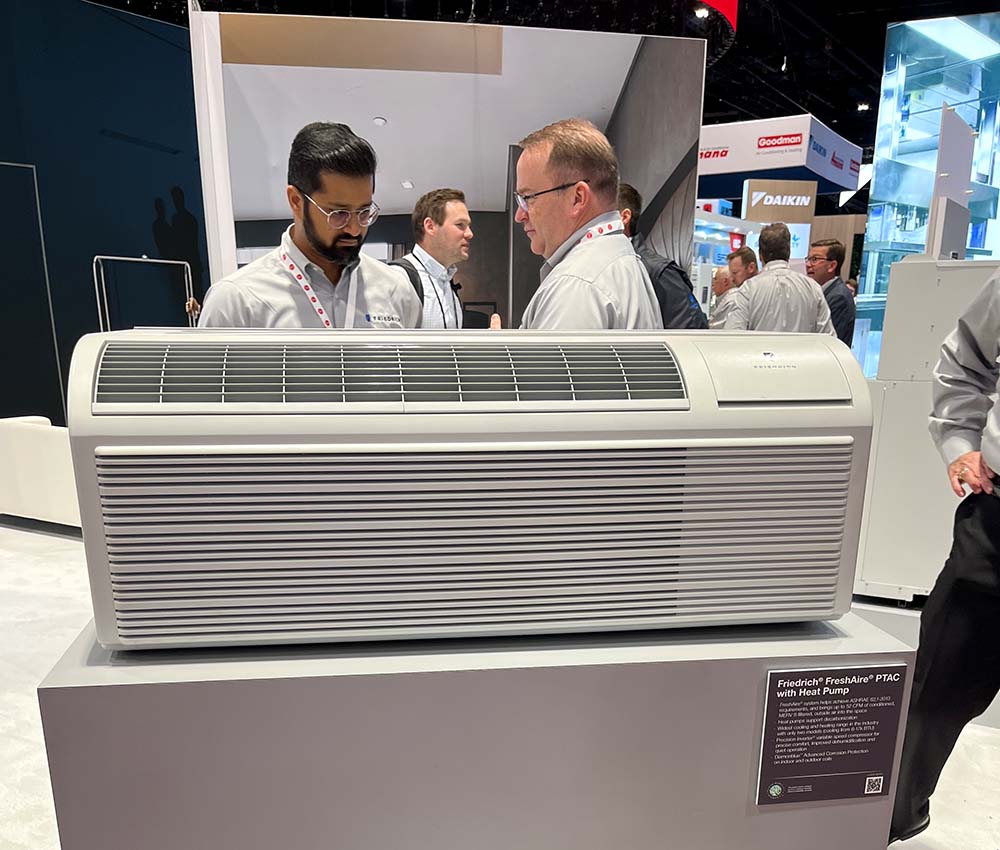
MAKE-UP: The FreshAire PTAC on the 2024 AHR Expo show floor. (Staff photo)
The FreshAire PTAC features a precision inverter compressor, plus a built-in FreshAire makeup air system that allows for enhanced indoor environment control.
“When Friedrich develops a product, we not only consider the product and specifications it needs to meet — we also consider the installers, servicers, distributors, and users of the products throughout the process,” Wheeler said.
Ventilation
Improving ventilation remains a focus for the industry, as code requirements also play a role in how it can be provided.
"In light of evolving standards and regulations, such as the International Energy Conservation Code (IECC) 2021, it is imperative for us to align with these benchmarks for ventilation," stated Maskel.
The energy code impacts ventilation because as homes are tightened up to meet new energy standards, there are fewer passive heat exchangers.
New construction (another trend AprilAire is seeing) only heightens the need for ventilation itself, and to meet the tighter hauls around it, mechanical ventilation has come more and more into play.
“The efficacy of that is the trend that we're really seeing starting to rise on supply ventilation — up to 4.4 cfm per watt — and it's also driving balanced ventilation quite a bit now,” said Joseph Hillenmeyer, AprilAire product manager, ventilation.
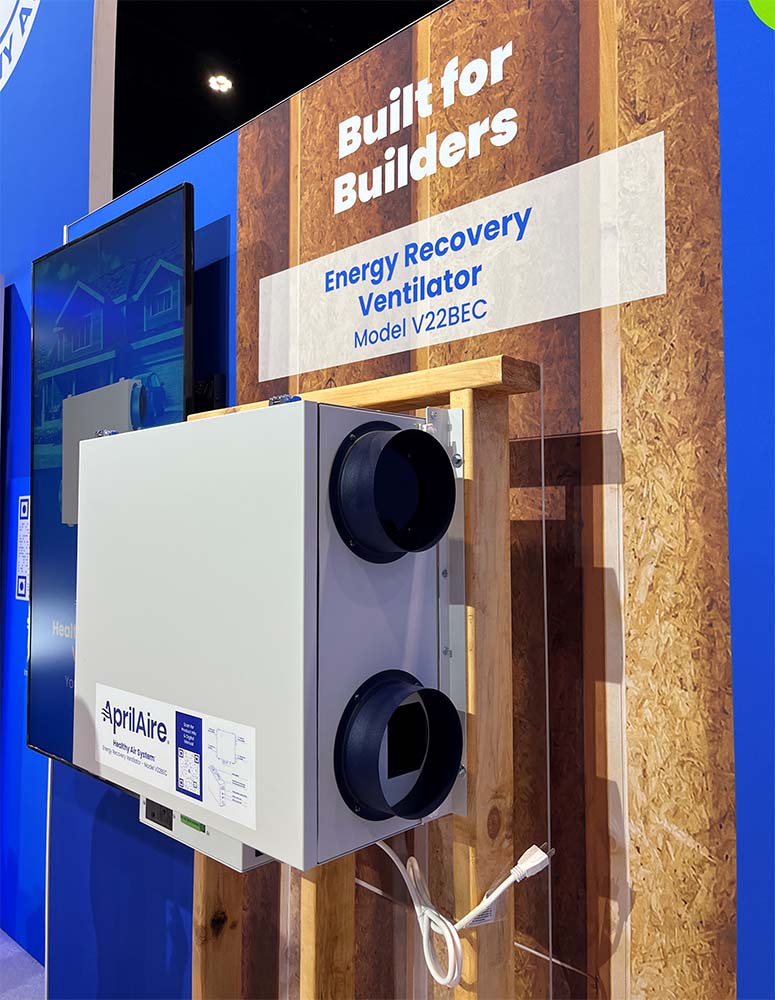
CODE: The ERV Model V22BEC meets both the IECC 2021 requirements and ASHRAE 62.2. (Staff photo)
AprilAire has released an ERV specifically for the high-volume builder market, with the goal of providing a more cost-effective solution.
"Traditionally, higher volume builders have been hesitant to embrace such products due to their cost implications,” said Hillenmeyer. “However, the current landscape, marked by elevated energy requirements, necessitates a shift towards products like our ERV that strike a balance between performance and cost.”
Bringing in fresh air from outside in order to build a healthier indoor air environment, without adding more equipment that will increase energy usage, is a lot easier said than done.
“Every building is different, and each needs its own comfort plan,” said Jim Flickinger, chief commercial officer at Big Ass Fans. “We ensure that they are getting the right solutions for their needs with products that move the air where it is needed: to the people.”
Big Ass Fans does this by moving outside air throughout the building in order to achieve natural ventilation.
“We’ve developed HVLS (high volume, low speed) fans to distribute air exactly where it needs to be through the use of patented foil and winglet designs and can measure/substantiate performance,” Flickinger said.
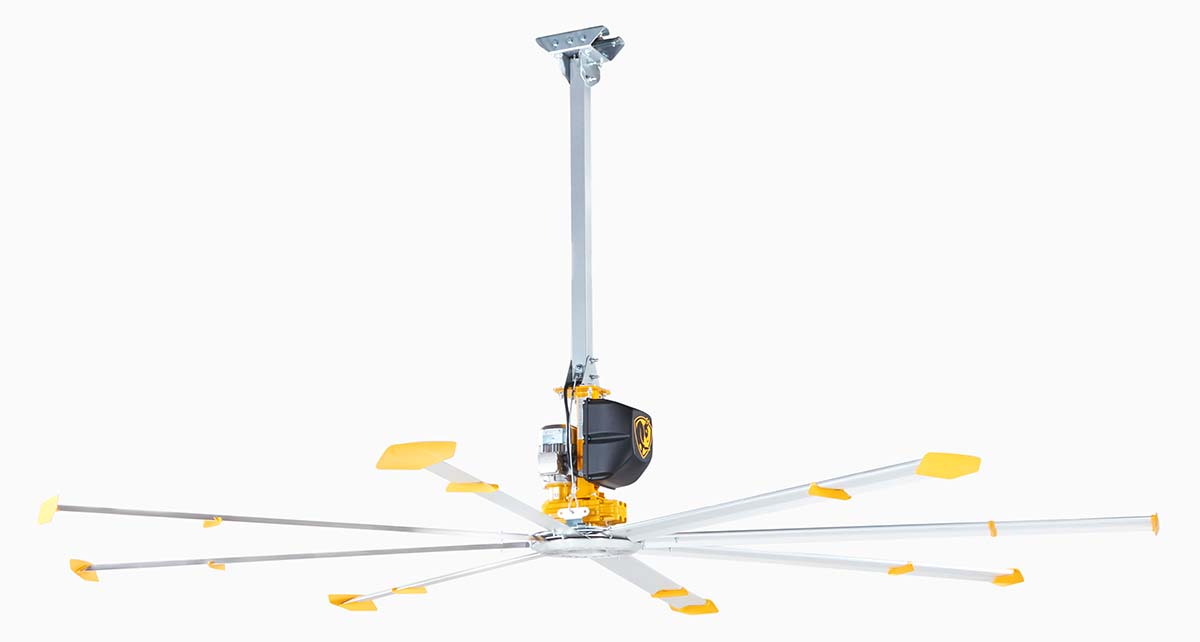
HVLS: A high-volume, low-speed fan, like the PFX 4, distributes air exactly where it needs to be through the use of patented foil & winglet designs. (Courtesy of Big Ass Fans)
Big Ass Fans products serve as a complement to the world of HVAC. They offer products that stratify the warm air that rises to the ceiling and bring it back to the indoor area in order to help HVAC systems balance the building temperature with less energy usage.
“Where we differ from other companies comes from our ability to deliver solutions from start to finish,” Flickinger said. “We go in and do a complete facility layout using our propriety SpecLab software. This allows the customer to see all the temperature extremes in the building, how we will lay out our products, and then produce results for our solutions. The customer knows exactly what they are getting.”
indoor air quality product manager
Lennox
Filtration
Dr. Nasim Rahman, Lennox indoor air quality product manager, said the company is seeing an increase in both ventilation and filtration needs. On the ventilation side (one of Lennox’s fastest growing categories), they’ve also seen an increase in demand for ERVs and heat recovery ventilators (HRVs). On the filtration side, consumers want a higher-grade filter and more purification. The company offers Healthy Climate branded Carbon Clean 16 filters that are the ultimate offering in clean filtration and reduce ozone. In fact, it removes 99% of the viruses, bacteria, and fungal spores.
“Lennox provides a whole home solution for all of our customers,” Rahman said. “Our solutions include a Smart Air Quality Monitor to provide a full picture of the air quality conditions in the home and to activate your HVAC/IAQ system on demand when there is an IAQ issue in the house.”
Now to take filtration a step further, Lennox also offers air purification products such as the In duct Air Purifier and PureAir air purification system. The Healthy Climate In-Duct Air Purifier is an ozone-free, duct-mounted, air purifier that effectively reduces VOCs and formaldehyde. PureAir features Lennox’s photocatalytic oxidation (PCO) technology and a hospital-grade filtration that removes 99% of viruses from the air as well as harmful VOCs and odors.
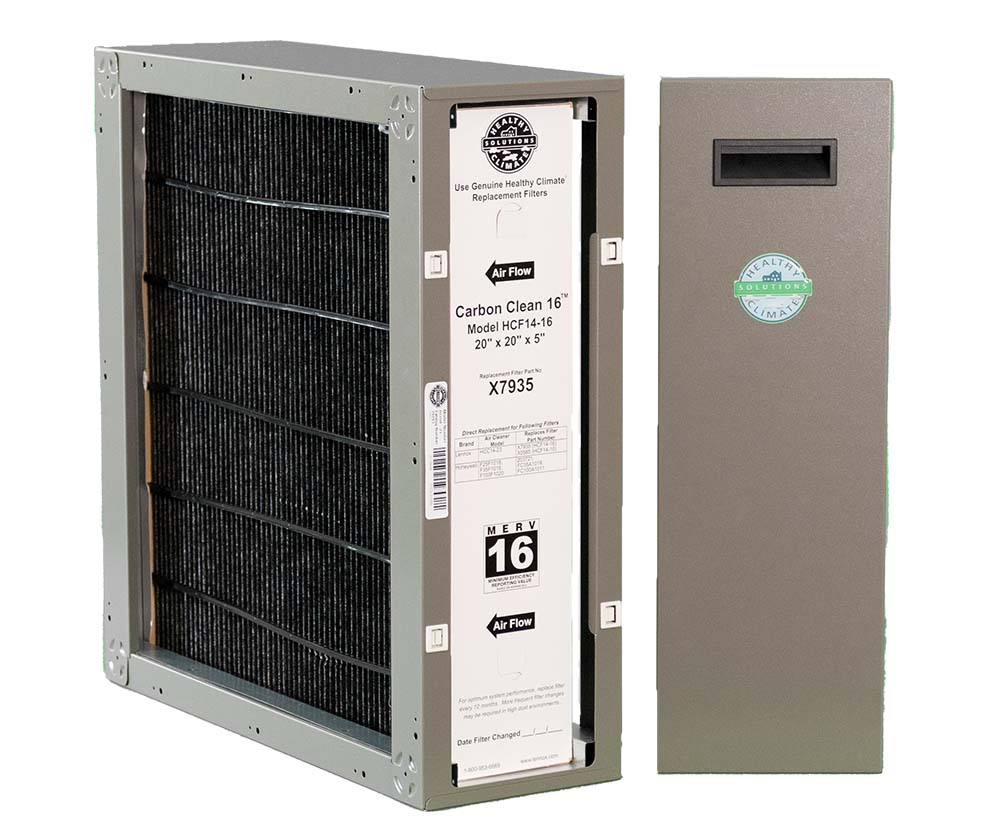
HEALTHY CLIMATE: A Lennox Healthy Climate MERV 16 filter. (Courtesy of Lennox)
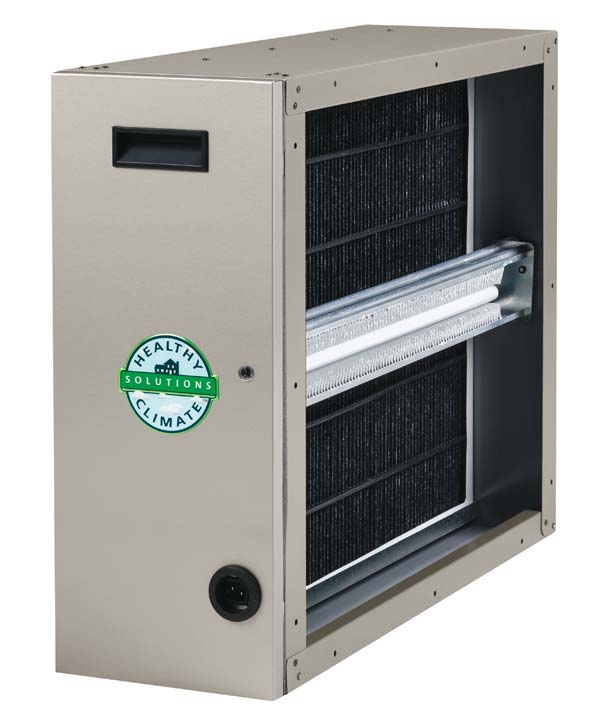
FILTRATION: Lennox’s PureAir and PureAir S rid of 99.9% of bacteria and viruses. (Courtesy of Lennox)
“In Lennox, we believe in having technology that’s not doing any harm to our customers,” Dr. Rahman said.
So, additionally, not only do these products not produce any ozone, but if there is any existing ozone in the house, it will remove that, too.
“At Lennox, we say, ‘Air is life, make it perfect.’ We believe we have the right indoor air quality products that can keep that promise of clean air to our customers, and we do that with PureAir, a whole home purification product,” Rahman said.






Report Abusive Comment